

Start Page : STEAM Songs - Videos - Experiments - Science Toys. STEAM Songs - Videos - Experiments - Science Toys. All About Matter. Balancing Balloons - Air Has Weight. This is a lesson about air. Science Lesson on Air Sara Broughton Topic : Air Grade Level : 2 Concept/Objective : The students will be able to explain how air has weight and occupies space, although we can not see it.
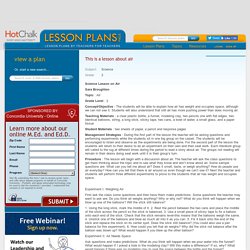
Students will also understand that still air has more pushing power than does moving air. Teaching Materials : a clear plastic bottle, a funnel, modeling clay, two pencils one with flat edges, two identical balloons, string, a long stick, sticky tape, two cans, a bowl of water, a small glass, and a paper tissue. Cool Science Experiment #9 (Dancing Oobleck) How to Make Oobleck- It's a Solid... No, It's a Liquid - Non-Newtonian Fluid.
Let's Make Oobleck! What are the 5 States of Matter? Plasma and Bose Einstein Condensate. States of Matter for Kids. Investigating Condensation and the Water Cycle. Step-by-step Lesson and Free Printables Most kids are familiar with the terms precipitation, condensation, and evaporation, but very few of them really understand what those words mean.
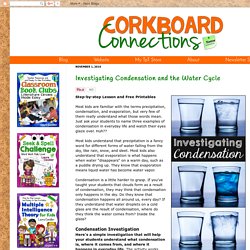
Just ask your students to name three examples of condensation in everyday life and watch their eyes glaze over. Huh?? Most kids understand that precipitation is a fancy word for different forms of water falling from the sky, like rain, snow, and sleet. Most kids also understand that evaporation is what happens when water "disappears" on a warm day, such as a puddle drying up. Condensation is a little harder to grasp. Condensation Investigation Here's a simple investigation that will help your students understand what condensation is, where it comes from, and where it happens in everyday life. Condensation Investigation is designed for students working in teams, but it's a teacher-directed exploration rather than an independent group activity.
Advance Preparation. Hot Air, Cold Air Science Activity. One of the most amazing highlights of my trip to Dubai was the opportunity to fly in a hot air balloon with Balloon Adventures Emirates.

It was incredible! The hot air balloon ride is the inspiration behind The Hot Air, Cold Air Science Activity. There is so much science behind the idea of hot air balloons and I thought that sharing the photos with my children of the balloon ride would be a great opportunity to extend this learning into a science activity. A Matter of State. A plastic bottle is compressed following a flight Photo Credit: Korte Purpose To help students understand that particle movement changes as a substance changes from one phase to another phase.
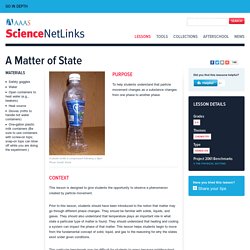
Context This lesson is designed to give students the opportunity to observe a phenomenon created by particle movement. Prior to this lesson, students should have been introduced to the notion that matter may go through different phase changes. KS2 Bitesize Science - Characteristics of materials : Fullscreen. 12 best images about Science: Matter en Pinterest. Chemistry. Water. Density 1.05. States of Matter: Basics Matter. Schools Science Clips - Changing state.
Schools Science Clips - Gases around us. Schools Science Clips - Solids and liquids. What is matter? slide show. MathMol Hypermedia Textbook for Elementary School-Grade 4. Lesson Plans. Math and Science Activities. Chemical and Physical Properties of Water and Ice. Solid State of Matter. These crystals of the mineral pyrite are a good example of a solid.
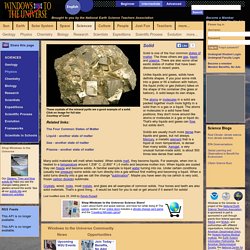
Click on image for full size Courtesy of Corel Solid is one of the four common states of matter. The three others are gas, liquid, and plasma. There are also some other exotic states of matter that have been discovered in recent years. Unlike liquids and gases, solids have definite shapes. How atoms are affected by heat. Matter: Properties. Global rating average: 0.0 out of 50.00.00.00.00.0 Find out how properties of matter describe its various states.

Discover the states of matter that exist on our planet and in the universe. Includes experiments with different states of matter and observing the changes as well as animated movies, lesson plans, worksheets, and online quizzes. Several sites have lesson plans for teachers. There are links to eThemes Resources on gases, liquids, and solids, and mass and weight. Grades Links Explore links on this page to learn about water and its three states. Three States of Matter - Free Science Lesson Plans, Activities, Powerpoints, Interactive Games. States of Matter.
States of Matter Barbara Pawela May School 512 S.
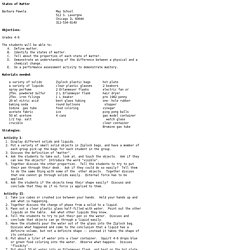
Lavergne Chicago IL 60644 312-534-6140 Objectives: Grades 4-6 The students will be able to: A. States of matter — Science Learning Hub. Anything that has mass is made up of matter – an all-encompassing word for atoms and molecules that make up our physical world. We describe this matter as existing in states (sometimes referred to as phases). Most people are familiar with three states of matter – solids, liquids and gases – but there are two more that are less commonly known but just as important – plasmas and Bose-Einstein condensates. STATES OF MATTER. - Distinguir entre las propiedades de sólidos, líquidos y gases. - Saber cómo están unidas las partículas según la Teoría Cinética de las Partículas. - Identificar los distintos cambios de estado y relacionarlos con fenómenos naturales y cotidianos.

FORMS OF MATTER - SOLID, LIQUID, GAS. Brain POP_Matter changing state. StudyJams. Matter and Heat/ Irreversible Changes. Fifth grade Lesson States of Matter Part 1. Inquiry Based Instructional Model To intertwine scientific knowledge and practices and to empower students to learn through exploration, it is essential for scientific inquiry to be embedded in science education.

While there are many types of inquiry-based models, one model that I've grown to appreciate and use is called the FERA Learning Cycle, developed by the National Science Resources Center (NSRC): 1. Focus 2. 3. 4. A framework for implementation can be found here. Fifth grade Lesson Physical Changes Versus Chemical Changes. The Focus of the Investigation: After our foldable is created, it is time to investigate some changes to practice identifying them as physical changes or chemical changes.

The students get very excited about some of these activities so it is important to help guide them to help them focus on what is most important, observing the changes that are occurring and watching for one of the indicators listed in the foldable. The Physical and Chemical Change Investigation Sheet that I use for this lesson has students identify properties before and after to help them notice these changes. Investigating in Small Groups: We do the rotations as a class, but each group completes the activities and investigation sheet together. Next, we move to the station 1 activity: Origami. We move on to station 2: Lava Lamps. Eighth grade Lesson Eliciting Student Ideas: What is Heat? What is Temperature?
This starts a series of lessons that introduce students to Heat and Temperature. I teach these in the context of a my unit on Changes in Earth's Atmosphere in order to apply the understanding of heat transfer on atmospheric phenomena as opposed to stand alone physical science lessons. This set of lessons gets students thinking about how heat is transferred through conduction, convection, and radiation. You begin with an elicit of student's ideas on heat and temperature followed by engaging them in discussion of their ideas. First up is a lesson from the American Chemical Society, where students complete an activity in which heat is transferred from hot water to metal washers and then from hot metal washers to water. Matter and Heat/ Irreversible Changes. Science Games For Kids: Properties of Materials. 2-PS1-2 Analyze data obtained from testing different materials to determine which materials have the properties that are best suited for an intended purpose.
Clarification Statement: Examples of properties could include, strength, flexibility, hardness, texture, and absorbency. Assessment Boundary: Assessment of quantitative measurements is limited to length. This resource was not designed to build towards this performance expectation, but can be used to build towards it using the suggestions provided below. Comments about Including the Performance Expectation The performance expectation is met through the interaction. Students analyze the data within the simulation, but this could be supported in a whole group activity on an overhead or chart. Matter and Heat/ Irreversible Changes. NGSS Hub. States of Matter: Quicksand Experiment. States of Matter - Experiments. Learning at Home: Science and the State of Matter. The Three States of Matter Song (NEW Video)
Matter Worksheets - Solid, Liquid, and Gas. This page contains a collection of printable materials for teaching students about states of matter (solid, liquid, gas). Includes a cut-and sort activity, higher-level thinking questions, and more. Science / 3rd/4th Grade States of Matter. Which Are a Solid, Liquid, Gas? What Happens When You Add Heat? 3rd Grade Reading - What Is Water? Third Grade Reading - Water in the 3rd Grade Reading - States of Water - Solids, Liquids, Documento sin título. 3 Amazing Science Experiments for Kids That You Can Do At Home. MathMol Hypermedia Textbook for Elementary School-Grade 4. Matter Facts for Kids. Some substances, like glass and water, allow light to pass through them. These substances are called transparent or see-through. The matter is still there, even though it can be hard to see. Humans are very good at changing matter to make things we can use. This can mean changing the shape of a natural object, such as carving wood or stone.
Or it can mean changing the substance itself, turning it into something else, for example smelting metal ores to extract pure metal. 4th grade unit c ch. 11 lesson 1 what is matter. How can water change. States of Matter_Action of the particles. Matter Compilation: Crash Course Kids. What is Matter? Water is everywhere-even in the air! People describe objects in many ways using size, shape, colors, and textures. Describing objects by using. What is matter? Matter Chatter (song for kids about solids, liquids, and gases) What is Matter? Is Air Made of Matter? How to Prove It. Strange Matter. Fifth Grade Happenings: Science: Matter, Lesson 1 - Properties of Matter. Matter. States of Matter - Solid, Liquid, Gases. Interesting Animated Lesson For Children. Solids Liquids and Gases for Kids. Matter (Solids, Liquids, Gases) - Free Science Games. Unit study: States of matter activities. States of Matter.
ABCya is the leader in free educational computer games and mobile apps for kids. The innovation of a grade school teacher, ABCya is an award-winning destination for elementary students that offers hundreds of fun, engaging learning activities. Millions of kids, parents, and teachers visit ABCya.com each month, playing over 1 billion games last year.
Apple, The New York Times, USA Today, Parents Magazine and Scholastic, to name just a few, have featured ABCya’s popular educational games. ABCya’s award-winning Preschool computer games and apps are conceived and realized under the direction of a certified technology education teacher, and have been trusted by parents and teachers for ten years. Materials and their properties (explained) Materials song (3rd/4th) Composite Materials. The Earth’s materials – Are we wasting them? KS2 Science The Sustainable Earth. Strange Matter: What is Materials Science? Who are materials scientists and what do they do? The Science Spot. Teaching Ideas. Materials song (1st/2nd) MATERIALS SONG. Materials Science Project Ideas.